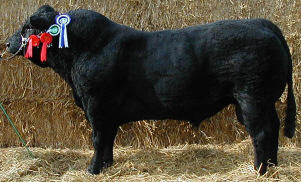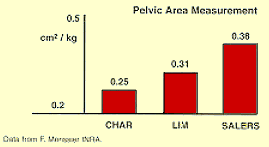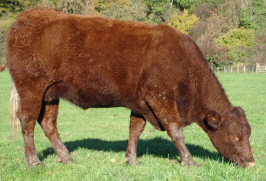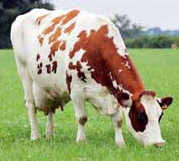



Salers
History
The breed pronounced 'Sa-Lair', originate in the Southern half of the Massif Central in the Auvergne region of France.This isolated, mountainous area (2000 to 6000ft) noted for its rough, rocky terrain and harsh, damp climate is characterised by poor soil and a wide range of temperatures throughout the summer and long winter. As the topography allowed for little cereal grain production, the Salers cattle were forced to become foragers with bred-in range-ability to utilise, almost entirely, native grasses in summer and hay in winter.
The breed Salers is one of the oldest breeds in the world, with prehistoric cave paintings suggesting that a similar type of animal has been bred in the area for 7-10,000 years. The drawings were found near Salers, a small medieval town in the centre of France.
Until modern times Salers cattle were respected not only as beef animals, but as milk producers for cheese products and were also used as strong sources of animal power.
 Photo courtesy of Rigel Pedigree, www.rigelpedigree.com |
In France today, only about 10% of the Salers herds are still milked, the remainder being used for beef production.
The milk is traditionally used to produce Appellation d'Origine Contrôlée (AOC) cheese such as the Cantal and the Salers. The Salers breed is also used to produce veal calves by cross breeding with the Charolais.
Characteristics
Salers cattle are typically horned and are dark mahogany red in colour, however a growing number are now polled and black. The availability of polled genetics in addition to both red and black, gives Salers the advantage of a flexible breeding program.The skin and membranes are brown, this reduces the occurance of eye or udder problems. Salers coat becomes thick and curly in winter this increases hardiness and adaptability to cold and heat.
Having roamed the mountains for centuries and been draught animals they have developed strong legs and good feet with black hooves. Consequently the cattle can travel long distances over rough ground without developing foot problems.
Being one of the oldest and genetically most pure of the European breeds, the Salers produces a positive effect on the predictability in crossbreeding programmes in a consistent increase in hybrid vigour.
At birth, Salers calves are typically long and slender and have small heads. This shape contributes to their calving ease.
 Photo courtesy of Rigel Pedigree, www.rigelpedigree.com |
Salers females are usually very conscientious and vigilant mothers, often caring for other calves in the group as well as their own.
The Salers has the largest, well shaped pelvic area of the major beef breeds which accounts for their exceptional calving ease and it also has a shorter than average gestation period.
As a breed Salers are very intelligent and calm in temperament.
Statistics
- Cows wear longer - 10% less depreciation
- Easier calving - 10% extra calves
- Less replacements - 10% saving on foster calves
- Less bad calving - 10% saving on vets bills
- Fitter calves born
- Own replacement heifers - 20% more value for heifers
- Extra heifers for sale as breeders
- Less labour needed for calving surveillance - 10% less labour needed
- Better milking cows - 10% saving on feed
- Better grazers
- A female can produce almost 3000 kg of fat-rich milk in her lifetime.
- Salers females are extremely fertile.
Comparative
Research of 59,000 cows of 28 breeds show Salers dams weaned the heaviest (200 day) calves of any breed.The Salers is the ideal suckler dam, having been selected over the centuries for the maternal traits of high milk yield from rough forage, early maturity (first calf at two years old) and short calving interval. She is capable of calving the progeny from the more muscled terminal sires without assistance.
Structure
The Montana State University in the USA measured 153 Salers, 175 Angus and 94
 Hereford yearlings and found the average pelvic areas of the Salers to be 15 square centimetres greater than the Herefords and 10 square centimetres greater than the Angus. In a similar study, the Colorado State University measured more than 900 yearlings representing 17 breeds in the USA and again confirmed that Salers had, on average, larger pelvic areas than any of the other breeds examined.
Hereford yearlings and found the average pelvic areas of the Salers to be 15 square centimetres greater than the Herefords and 10 square centimetres greater than the Angus. In a similar study, the Colorado State University measured more than 900 yearlings representing 17 breeds in the USA and again confirmed that Salers had, on average, larger pelvic areas than any of the other breeds examined. Milkiness
Research conducted in France with 4864 lactations found Salers to have an average daily milk production of 11.1 litres over a 274 day lactation (more than 3000 litres). By comparison, this same trial shows Charolais at 5.7 and Limousins at 4.9 litres per day. Also, high protein milk necessary for cheese production is another Salers characteristic.
Calving
Research of 59,000 cows of 28 breeds show Salers dams weaned the heaviest (200 day) calves of any breed.
The Virginia Polytechnic Institute and State University in the USA conducted a study in which Salers bulls and Angus bulls were used over similar heifers to evaluate calving ease. Birth weights of calves were similar - 33 and 34kg - but the Salers sires gave 10% fewer calving difficulties. The significant difference in the study was that all the Salers sired calves survived to weaning while only 63% of the Angus sired calves survived.
| Expected ease of calving (% unassisted) for matings to heifers. | |||||
| Sire Breed | Number | Matings within breed | Matings across all breeds | ||
| Salers | 2673 | 89 | 84 | ||
| Angus | 2748 | 81 | 80 | ||
| Hereford | 6967 | 79 | 77 | ||
| Charolais | 6855 | 70 | 68 | ||
| Simmental | 6294 | 68 | 65 | ||
| Data from P.G. Sullivan & J.W. Wilton. University of Guelph Publication. | |||||
Bulls
Basalt Grazing Company of Rolleston, Queensland, used a Salers bull in each of two paddocks with seven or eight other bulls and 220 cows. In these two paddocks, the pregnancy rate was 96% while in another nine mating groups with similar numbers but without Salers bulls, the calving percentage was consistently 80%. This represents a 20% increase in production with no extra cost.
Meat
The Salers combines continental carcase conformation (kills out greater than 60%) with a traditional marbling to give a high quality meat much appreciated by the butcher.
Distribution
Currently, there are about 300,000 head of Salers in France. They have also been exported Photo courtesy of Rigel Pedigree, www.rigelpedigree.com |
References (the above information was cited from the following sites)
www.salers-cattle-society.co.uk
www.tasc.ie
www.ansi.okstate.edu
salers.une.edu.au
www.salers.org.nz
www.rigelpedigree.com


